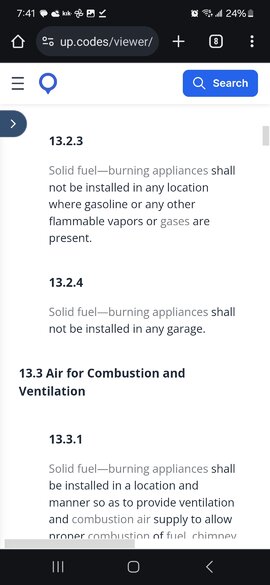Greetings All,
I recently built a wood stove out of a modified heating oil tank (1st pic) based on a design I saw on youtube (2nd picture). We had a large garage built 2 summers ago and originally tried to heat it w a fisher papa bear (3rd pic). the fisher install is 6 inch pipe straight up to the roof from a rear exit stove. insulation for the garage/shop is the standard pull building insulation that comes with a kit ( reflective on one side approximately 3 inches of material sandwiched between the exterior tin and the girds. Shop is 2100 ft.² floor space with 14 foot walls in an open truss ceiling. There is a ceiling fan installed. as one might guess, the papa bear does not heat the shop very well. During the winter with temperatures in the 20s outside, temperatures in the shop are 35 and after running the stove on to full loads temperatures are only up into the 40s. insulation in the roof will eventually be installed but building the stove was a much less expensive solution to try and increase the heat in the shop this winter.
Watching YouTube, I saw the modified tank and a larger shop and the gentleman (tom bicandi ) seemed to be very happy with it. he used an 8 inch exhaust pipe.
Seeing as I had most of the material close at hand and I wanted a welding project I decided to build a similar stove. I am using the original 6 inch pipe but due to the top exit on the stove, in order to maintain appropriate distances from the heat source 1 needed to place 2-45° bends in the exhaust pipe. Setback is about 22 inches from a tin heat shield with a 1 inch air gap using pipe as a spacer.
If he heats pretty well and yesterday I was able to bring the shop temperature up to 70 degrees. I am still considering whether am going to modify it by putting more heat exchange tubes in. I will be using a squirrel cage blower and fashioning a shroud for the blower at a later date. Currently I have a 20 inch industrial fan with roof tin as a make shift shroud around the posterior pipes as a temp fan/blower.
This is the problem... I get pretty serious by back puffs/buffetting on start up as it is getting to temperature. Makes a little smoky in the shop. any ideas on how to make that go away? I am using 2-3/8 inch pipe from a exchanger tubes and my air intake. Eventually I will be adding more exchanger tubes probably 6-8 more and then I will clean the surface and paint it. Although not seen in the picture, a fire extinguisher is handy.
I appreciate your input.
RP
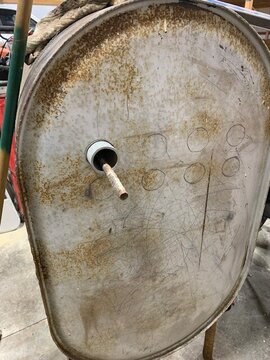
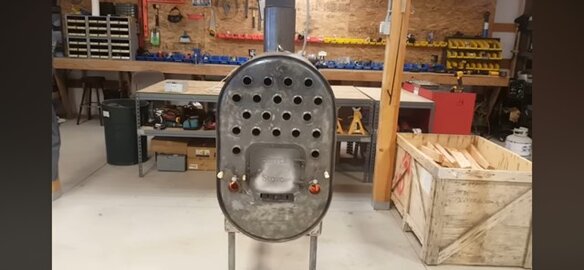
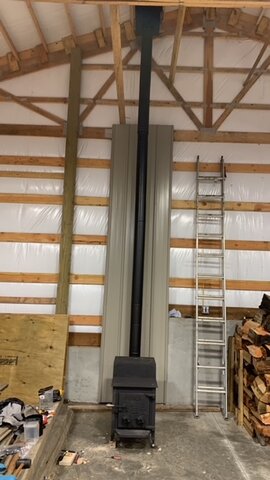
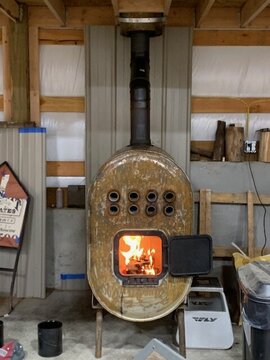
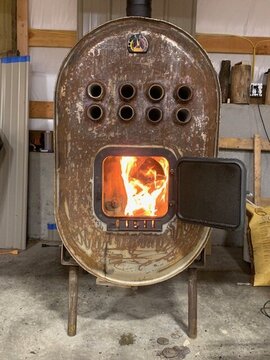
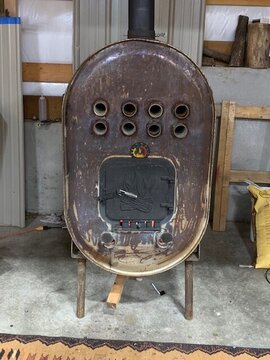
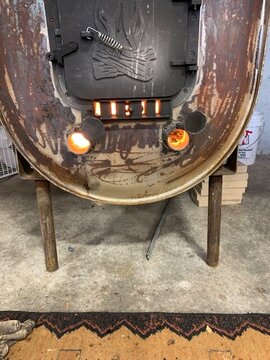
I recently built a wood stove out of a modified heating oil tank (1st pic) based on a design I saw on youtube (2nd picture). We had a large garage built 2 summers ago and originally tried to heat it w a fisher papa bear (3rd pic). the fisher install is 6 inch pipe straight up to the roof from a rear exit stove. insulation for the garage/shop is the standard pull building insulation that comes with a kit ( reflective on one side approximately 3 inches of material sandwiched between the exterior tin and the girds. Shop is 2100 ft.² floor space with 14 foot walls in an open truss ceiling. There is a ceiling fan installed. as one might guess, the papa bear does not heat the shop very well. During the winter with temperatures in the 20s outside, temperatures in the shop are 35 and after running the stove on to full loads temperatures are only up into the 40s. insulation in the roof will eventually be installed but building the stove was a much less expensive solution to try and increase the heat in the shop this winter.
Watching YouTube, I saw the modified tank and a larger shop and the gentleman (tom bicandi ) seemed to be very happy with it. he used an 8 inch exhaust pipe.
Seeing as I had most of the material close at hand and I wanted a welding project I decided to build a similar stove. I am using the original 6 inch pipe but due to the top exit on the stove, in order to maintain appropriate distances from the heat source 1 needed to place 2-45° bends in the exhaust pipe. Setback is about 22 inches from a tin heat shield with a 1 inch air gap using pipe as a spacer.
If he heats pretty well and yesterday I was able to bring the shop temperature up to 70 degrees. I am still considering whether am going to modify it by putting more heat exchange tubes in. I will be using a squirrel cage blower and fashioning a shroud for the blower at a later date. Currently I have a 20 inch industrial fan with roof tin as a make shift shroud around the posterior pipes as a temp fan/blower.
This is the problem... I get pretty serious by back puffs/buffetting on start up as it is getting to temperature. Makes a little smoky in the shop. any ideas on how to make that go away? I am using 2-3/8 inch pipe from a exchanger tubes and my air intake. Eventually I will be adding more exchanger tubes probably 6-8 more and then I will clean the surface and paint it. Although not seen in the picture, a fire extinguisher is handy.
I appreciate your input.
RP









